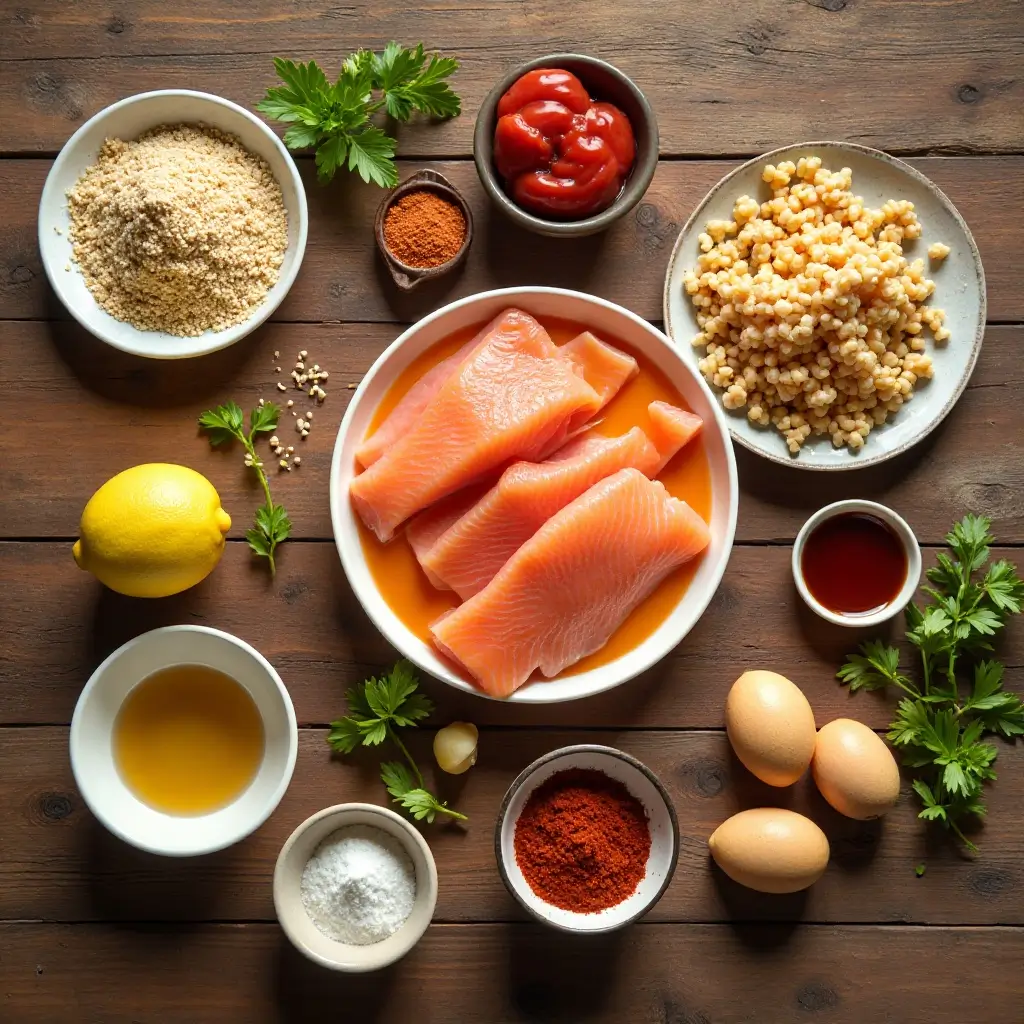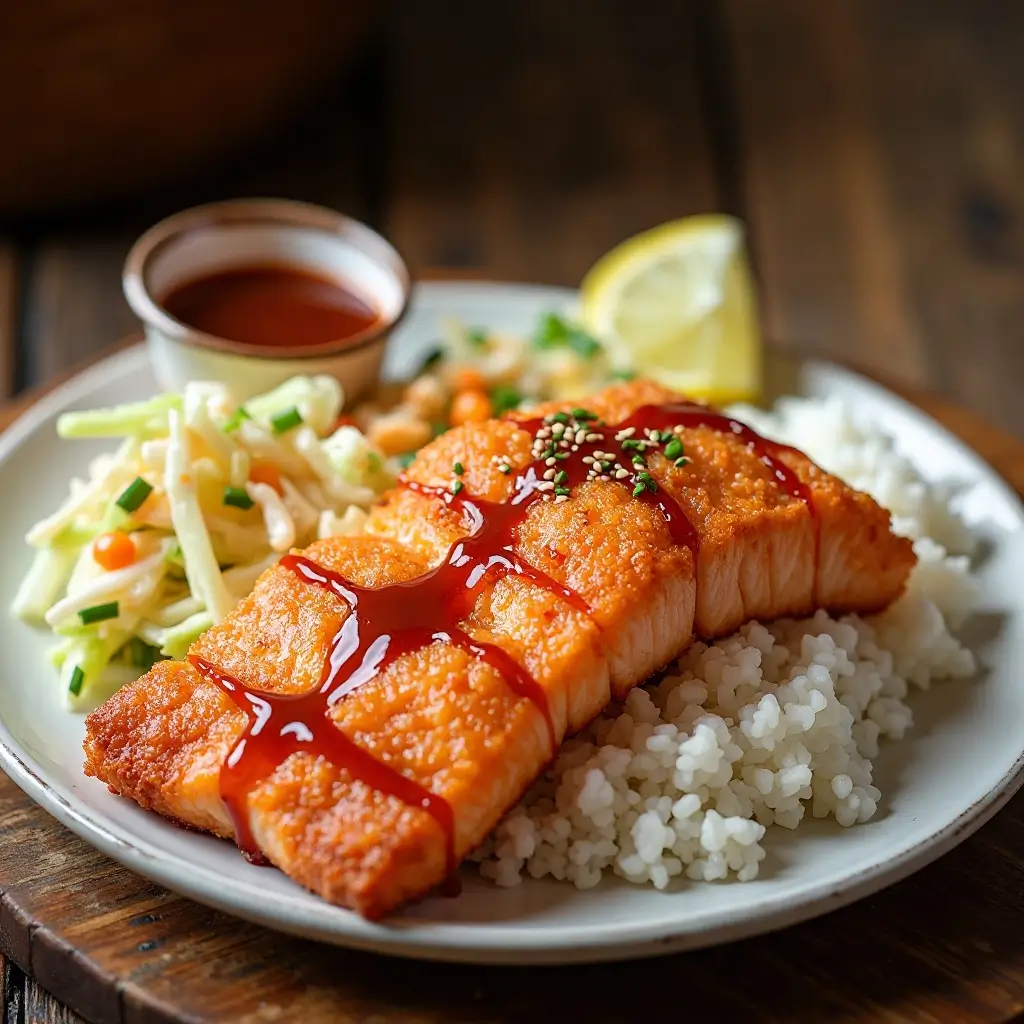Crispy Salmon Katsu Recipe
Golden, crispy, and absolutely irresistible – salmon katsu transforms ordinary salmon into an extraordinary Japanese comfort dish that’s surprisingly simple to make at home. This panko-crusted delight delivers restaurant-quality flavors without breaking the bank, making it perfect for busy weeknights when you want something special.
Just like our popular chicken teriyaki bowl, this recipe brings authentic Japanese flavors to your dinner table with minimal effort and maximum satisfaction.
Table of Contents
What is Salmon Katsu?
Ever wondered why the Japanese have such a genius way with fried foods? Salmon katsu is basically salmon’s fancy cousin – think fish and chips went to culinary school in Tokyo! This crispy, golden masterpiece gets its name from “katsu,” meaning cutlet, and trust me, once you bite into that crunchy panko exterior revealing tender, flaky salmon inside, you’ll understand why they say the way to anyone’s heart is through their stomach. Ready to impress your dinner guests?
Why You’ll Love This Salmon Katsu:
Restaurant-Quality Results at Home
This salmon katsu delivers that satisfying crunch you crave from your favorite Japanese restaurant, but for a fraction of the cost. The golden panko coating creates the perfect contrast to the tender, flaky salmon inside, giving you textures that dance on your palate with every bite.
Budget-Friendly Family Favorite
Making salmon katsu at home saves you serious money compared to ordering it out. A single restaurant portion can cost $20 or more, but you can feed your entire family for less than half that price. Plus, you control the quality of ingredients and can customize the size of each portion.
Flavor Explosion in Every Bite
The combination of crispy panko breadcrumbs, perfectly seasoned salmon, and that tangy katsu sauce creates a flavor profile that’s both comforting and exciting. Much like our beloved honey garlic salmon, this dish proves that simple ingredients can create extraordinary results. Why not give both recipes a try and discover your new favorite way to prepare salmon?
How to Make Salmon Katsu:
Quick Overview
This salmon katsu recipe is surprisingly straightforward and incredibly rewarding. The key to success lies in the three-step breading process that creates an ultra-crispy exterior while keeping the salmon moist and tender inside.
Prep Time: 15 minutes
Cook Time: 10 minutes
Total Time: 25 minutes
Servings: 4
Key Ingredients for Salmon Katsu:
For the Salmon:
- 4 salmon fillets (6 oz each), skin removed
- 1 teaspoon salt
- 1/2 teaspoon black pepper
- 1/2 teaspoon garlic powder
For the Breading Station:
- 1 cup all-purpose flour
- 3 large eggs, beaten
- 2 cups panko breadcrumbs
- 1 teaspoon paprika
- 1/2 teaspoon onion powder
For Cooking:
- Vegetable oil for frying (about 2 cups)
- Lemon wedges for serving
For Katsu Sauce:
- 1/4 cup ketchup
- 2 tablespoons Worcestershire sauce
- 1 tablespoon soy sauce
- 1 teaspoon honey
- 1/2 teaspoon garlic powder

Step-by-Step Instructions:
Step 1: Prepare the Salmon Pat the salmon fillets completely dry with paper towels. This is crucial for proper breading adhesion. Season both sides evenly with salt, pepper, and garlic powder. Let the salmon rest at room temperature for 10 minutes while you prepare the other components.
Step 2: Set Up Your Breading Station Arrange three shallow dishes in a row. Fill the first with flour, the second with beaten eggs, and the third with panko breadcrumbs mixed with paprika and onion powder. This assembly line approach makes the breading process smooth and efficient.
Step 3: Heat the Oil Pour vegetable oil into a heavy-bottomed pan or deep skillet to a depth of about 2 inches. Heat over medium-high heat until it reaches 350°F (175°C). Use a cooking thermometer for accuracy, or test with a small piece of bread – it should sizzle immediately and turn golden in 30 seconds.
Step 4: Bread the Salmon Working with one fillet at a time, dredge in flour, shaking off excess. Dip into beaten eggs, allowing excess to drip off. Finally, press firmly into the panko mixture, ensuring complete coverage on both sides. The key is pressing gently but firmly to help the breadcrumbs adhere.
Step 5: Fry to Golden Perfection Carefully lower the breaded salmon into the hot oil using tongs. Fry for 3-4 minutes on the first side until deep golden brown. Flip carefully and fry for another 2-3 minutes until the second side matches. The internal temperature should reach 145°F (63°C).
Step 6: Drain and Rest Transfer the fried salmon katsu to a wire rack or paper towel-lined plate. Let it rest for 2-3 minutes to allow excess oil to drain and the coating to set. This brief rest ensures maximum crispiness.
Step 7: Make the Katsu Sauce While the salmon rests, whisk together all sauce ingredients in a small bowl until smooth. Taste and adjust sweetness or tanginess as desired. The sauce should be glossy and well combined.
Step 8: Serve Immediately Slice each katsu diagonally into thick strips if desired, and serve immediately with the katsu sauce and lemon wedges. The contrast between the hot, crispy exterior and tender salmon inside is best enjoyed right away.
What to Serve Salmon Katsu With:
Salmon katsu pairs beautifully with steamed jasmine rice or Japanese short-grain rice to soak up the delicious katsu sauce. Add a crisp cabbage slaw dressed with rice vinegar for freshness and crunch that complements the rich, fried salmon.
Consider serving alongside miso soup and pickled vegetables for an authentic Japanese meal experience. For a fusion approach, try it with roasted vegetables like asparagus or baby bok choy, or even over a bed of mixed greens for a lighter option.
Green tea or cold Japanese beer make excellent beverage pairings that cleanse the palate between bites of this indulgent dish.

Top Tips for Perfecting Salmon Katsu:
Choose the Right Salmon
Opt for thick, center-cut salmon fillets that are at least 1-inch thick. This ensures the fish stays moist during frying while the coating becomes perfectly crispy. Avoid thin tail pieces that can overcook quickly.
Master the Oil Temperature
Maintain oil temperature between 340-350°F throughout cooking. Too hot, and the coating burns before the salmon cooks through. Too cool, and you’ll end up with greasy, soggy katsu. Adjust heat as needed and fry in batches to avoid overcrowding.
The Double-Dip Technique
For extra crispy results, dip the floured salmon back into the egg wash, then into the panko again. This double coating creates an incredibly crunchy exterior that rivals any restaurant version.
Don’t Skip the Rest
Let the breaded salmon rest for 5 minutes before frying. This helps the coating adhere better and prevents it from falling off during cooking. The brief wait is worth the superior results.
Substitution Suggestions
No panko? Regular breadcrumbs work, but toast them lightly in a dry pan first for better texture. For gluten-free options, use almond flour for dredging and crushed rice crackers or gluten-free breadcrumbs for coating.
Storing and Reheating Tips:
Refrigerator Storage: Store leftover salmon katsu in an airtight container in the refrigerator for up to 3 days. Place parchment paper between pieces to prevent sticking and maintain crispiness.
Freezing Instructions: For longer storage, wrap individual pieces in plastic wrap and freeze for up to 2 months. Thaw overnight in the refrigerator before reheating.
Reheating for Best Results: Skip the microwave, which makes the coating soggy. Instead, reheat in a 375°F oven for 8-10 minutes, or use an air fryer at 350°F for 3-4 minutes until heated through and crispy again.
Make-Ahead Tips: You can bread the salmon up to 4 hours ahead and refrigerate until ready to fry. This actually helps the coating adhere better. Just remove from the fridge 15 minutes before cooking to take off the chill.
Nutritional Information
| Nutrient | Per Serving |
|---|---|
| Calories | 485 |
| Protein | 36g |
| Carbohydrates | 28g |
| Fat | 24g |
| Saturated Fat | 4g |
| Omega-3 Fatty Acids | 1.8g |
| Sodium | 680mg |
| Fiber | 1g |
Nutritional values are approximate and based on standard ingredient measurements
Frequently Asked Questions
Can I bake salmon katsu instead of frying?
Yes! Preheat your oven to 425°F and place breaded salmon on a wire rack over a baking sheet. Spray lightly with cooking oil and bake for 12-15 minutes until golden and crispy. While not as crispy as fried, it’s a healthier alternative.
What’s the best type of salmon to use?
Atlantic or Norwegian salmon work beautifully due to their higher fat content, which keeps the fish moist during cooking. Wild-caught Alaskan salmon is also excellent, though it may cook slightly faster due to lower fat content.
Can I make katsu sauce ahead of time?
Absolutely! Katsu sauce actually improves in flavor when made a day ahead. Store covered in the refrigerator for up to one week. Bring to room temperature before serving for the best consistency.
How do I know when the oil is ready for frying?
The most accurate method is using a thermometer – aim for 350°F. Alternatively, drop a small piece of bread into the oil; it should sizzle immediately and turn golden brown within 30 seconds.
Can I use frozen salmon for this recipe?
Yes, but thaw it completely first and pat very dry. Frozen salmon tends to release more moisture, so extra drying time is crucial for proper breading adhesion.
What if I don’t have panko breadcrumbs?
Regular breadcrumbs work, but for better texture, pulse them in a food processor to create coarser crumbs, or lightly toast them in a dry pan. You can also use crushed cornflakes for an interesting twist!
How can I make this recipe spicier?
Add cayenne pepper or chili powder to the panko mixture, or incorporate sriracha into the katsu sauce. Start with small amounts and adjust to your heat preference.
Is salmon katsu gluten-free?
Not traditionally, but you can easily adapt it. Use rice flour or almond flour for dredging, and substitute gluten-free breadcrumbs or crushed rice crackers for the panko coating.
This salmon katsu recipe proves that creating restaurant-quality Japanese cuisine at home is not only possible but incredibly rewarding. The combination of crispy textures, tender fish, and that perfect tangy-sweet katsu sauce makes this dish an instant family favorite that’s sure to become a regular in your dinner rotation.
